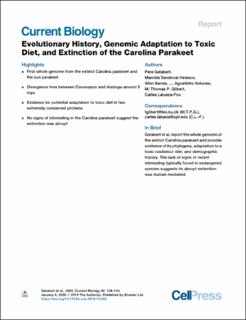| dc.contributor.author | Gelabert, Pere | |
| dc.contributor.author | Sandoval-Velasco, Marcela | |
| dc.contributor.author | Serres, Aitor | |
| dc.contributor.author | de Manuel, Marc | |
| dc.contributor.author | Renom, Pere | |
| dc.contributor.author | Margaryan, Ashot | |
| dc.contributor.author | Stiller, Josefin | |
| dc.contributor.author | De-Dios, Toni | |
| dc.contributor.author | Fang, Qi | |
| dc.contributor.author | Feng, Shaohong | |
| dc.contributor.author | Mañosa, Santi | |
| dc.contributor.author | Pacheco, George | |
| dc.contributor.author | Ferrando-Bernal, Manuel | |
| dc.contributor.author | Shi, Guolin | |
| dc.contributor.author | Hao, Fei | |
| dc.contributor.author | Chen, Xianqing | |
| dc.contributor.author | Petersen, Bent | |
| dc.contributor.author | Olsen, Remi-André | |
| dc.contributor.author | Navarro, Arcadi | |
| dc.contributor.author | Deng, Yuan | |
| dc.contributor.author | Dalén, Love | |
| dc.contributor.author | Marques-Bonet, Tomas | |
| dc.contributor.author | Zhang, Guojie | |
| dc.contributor.author | Antunes, Agostinho | |
| dc.contributor.author | Gilbert, Marcus Thomas Pius | |
| dc.contributor.author | Lalueza-Fox, Carles | |
| dc.date.accessioned | 2021-01-12T15:13:59Z | |
| dc.date.available | 2021-01-12T15:13:59Z | |
| dc.date.created | 2021-01-11T11:44:44Z | |
| dc.date.issued | 2020 | |
| dc.identifier.citation | Current Biology. 2020, 30 (1), 108-114. | en_US |
| dc.identifier.issn | 0960-9822 | |
| dc.identifier.uri | https://hdl.handle.net/11250/2722637 | |
| dc.description.abstract | As the only endemic neotropical parrot to have recently lived in the northern hemisphere, the Carolina parakeet (Conuropsis carolinensis) was an iconic North American bird. The last surviving specimen died in the Cincinnati Zoo in 1918 [1]. The cause of its extinction remains contentious: besides excessive mortality associated to habitat destruction and active hunting, their survival could have been negatively affected by its range having become increasingly patchy [2] or by the exposure to poultry pathogens [3, 4]. In addition, the Carolina parakeet showed a predilection for cockleburs, an herbaceous plant that contains a powerful toxin, carboxyatractyloside, or CAT [5], which did not seem to affect them but made the birds notoriously toxic to most predators [3]. To explore the demographic history of this bird, we generated the complete genomic sequence of a preserved specimen held in a private collection in Espinelves (Girona, Spain), as well as of a close extant relative, Aratinga solstitialis. We identified two non-synonymous genetic changes in two highly conserved proteins known to interact with CAT that could underlie a specific dietary adaptation to this toxin. Our genomic analyses did not reveal evidence of a dramatic past demographic decline in the Carolina parakeet; also, its genome did not exhibit the long runs of homozygosity that are signals of recent inbreeding and are typically found in endangered species. As such, our results suggest its extinction was an abrupt process and thus likely solely attributable to human causes. | en_US |
| dc.language.iso | eng | en_US |
| dc.publisher | Elsevier | en_US |
| dc.rights | Navngivelse 4.0 Internasjonal | * |
| dc.rights.uri | http://creativecommons.org/licenses/by/4.0/deed.no | * |
| dc.title | Evolutionary History, Genomic Adaptation to Toxic Diet, and Extinction of the Carolina Parakeet | en_US |
| dc.type | Peer reviewed | en_US |
| dc.type | Journal article | en_US |
| dc.description.version | publishedVersion | en_US |
| dc.source.pagenumber | 108-114 | en_US |
| dc.source.volume | 30 | en_US |
| dc.source.journal | Current Biology | en_US |
| dc.source.issue | 1 | en_US |
| dc.identifier.doi | https://doi.org/10.1016/j.cub.2019.10.066 | |
| dc.identifier.cristin | 1868810 | |
| dc.description.localcode | (C) 2019 The Author(s). Published by Elsevier Ltd. This is an open access article under the CC BY license (http://creativecommons.org/licenses/by/4.0/) | en_US |
| cristin.ispublished | true | |
| cristin.fulltext | original | |
| cristin.qualitycode | 2 | |

